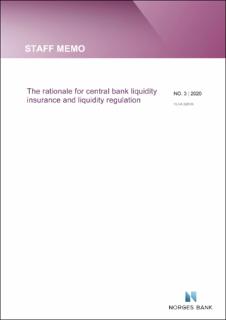| dc.contributor.author | Søvik, Ylva | |
| dc.date.accessioned | 2020-05-27T08:16:44Z | |
| dc.date.available | 2020-05-27T08:16:44Z | |
| dc.date.issued | 2020 | |
| dc.identifier.isbn | 978-82-8379-142-6 | |
| dc.identifier.issn | 1504-2596 | |
| dc.identifier.uri | https://hdl.handle.net/11250/2655724 | |
| dc.description.abstract | One of the core functions of a central bank is to provide liquidity insurance, often termed the lender of last resort (LLR) function. During and after the Great Financial Crisis (GFC) in 2007-09 central banks’ role as liquidity insurers evolved. In the aftermath of the crisis, regulation of liquidity risk in the financial sector has been tightened, and central bank policies are under evaluation. This survey gathers insights from the literature on how to design central bank liquidity insuring policies: What institutions to insure, how to price central bank facilities, what collateral to accept, the size of operations, the degree to which they should be on-going facilities or contingent, and the interaction of our liquidity policies with regulation. Some fundamental trade-offs are identified and discussed. | en_US |
| dc.language.iso | eng | en_US |
| dc.publisher | Norges Bank | en_US |
| dc.relation.ispartofseries | Staff Memo;3/2020 | |
| dc.rights | Attribution-NonCommercial-NoDerivatives 4.0 Internasjonal | * |
| dc.rights.uri | http://creativecommons.org/licenses/by-nc-nd/4.0/deed.no | * |
| dc.subject | liquidity insurance | en_US |
| dc.subject | lender of last resort | en_US |
| dc.subject | financial crisis | en_US |
| dc.subject | liquidity regulation | en_US |
| dc.title | The rationale for central bank liquidity insurance and liquidity regulation | en_US |
| dc.type | Working paper | en_US |
| dc.description.version | publishedVersion | en_US |
| dc.subject.nsi | VDP::Samfunnsvitenskap: 200::Økonomi: 210::Samfunnsøkonomi: 212 | en_US |
| dc.source.pagenumber | 24 | en_US |

